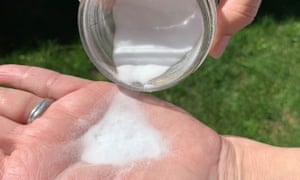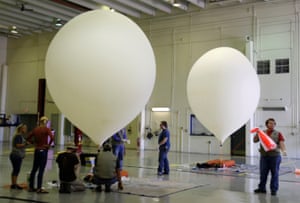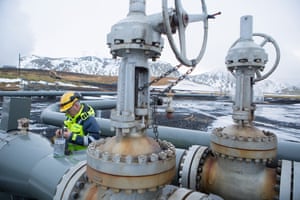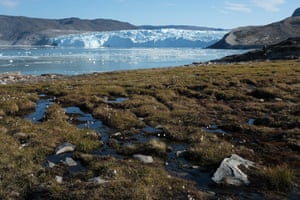Time is running out for the Arctic. The region continues to warm at two or three times the global rate and scientists now predict that we could see Arctic summer ice disappear as early as 2042.
As the realization sets in that existing emission reductions and renewable energy programs in place won’t be enough to save the Arctic, alternative geoengineering projects have gained traction as scientists look for a last-ditch solution. Some of them sound fantastical – but their proponents argue that there are precious few other options.
A layer of glass beads
The Arctic region suffers from a feedback loop called the Albedo effect where melting snow and ice exposes darker ocean which absorbs more heat from the sun and in turn melts more ice. To reverse this effect, a nonprofit called Arctic Ice Project has proposed sprinkling parts of the Arctic with a thin layer of glass beads that would boost surface reflectivity and create more ice, potentially starting a cooling feedback loop.
The beads are 35 micrometres in diameter and made from silica; a compound made up of oxygen and silicon, which is supposed to reflect 90% of the sun’s heat. Arctic Ice Project has tested the beads on ice-covered lakes in the Sierra Nevada mountains, Minnesota and Alaska and initial results have shown that they do increase ice reflectivity and thickness. Now, Leslie Field, the founder of the group, is targeting critical parts of the Arctic region, in particular the Fram Strait which lies between Greenland and the Norwegian island of Svalbard. Such an operation would cost around $300m, according to the Arctic Ice Project team.

Underwater sea walls
In 2018, John C Moore and Rupert Gladstone of the Arctic Centre, University of Lapland proposed a geoengineering project that would aim to slow the melt of fast-moving outlet glaciers such as the Thwaites glacier in western Antarctica and Jakobshavn glacier in Greenland.
The idea involves the construction of a sea wall or a free-floating design that could block the warm ocean currents from melting the glacier from below. “If you can turn the melting off, the ice shelf can re-ground” explains Moore. In the case of the Jakobshavn glacier, which drains around seven per cent of Greenland’s entire ice sheet, a barrier could be constructed across Ilulissat Fjord to block warm ocean currents reaching its lower reaches.
Rewilding the Arctic tundra

The family-run Pleistocene Park project has gradually reintroduced the mammoth steppe grassland ecosystem to swathes of Arctic tundra in northern Siberia over the past two decades. The project aims to reduce permafrost thaw in the Arctic, which emits a mixture of methane, carbon dioxide and nitrous oxide – all greenhouse gasses.
This process of rewilding was made possible by the introduction of large grazing animals such as bison, reindeer and horses that can re-engineer the landscape by trampling on or eating tree saplings. These large herbivores also trample on the snow cover, reducing its insulating effect and exposing the layer of permafrost below to colder temperatures.
According to a preliminary study inspired by the Pleistocene Park project, increasing the population and density of big herbivores in northern high-latitude ecosystems could preserve 80% of the world’s permafrost.
Millions of wind-powered pumps
Perhaps the most ambitious geoengineering proposal to date is the construction of 10m wind-powered pumps throughout the Arctic that would continually distribute seawater onto surface ice where it would then freeze. The idea, initially proposed in 2017 by researchers in the American Geophysical Union’s journal Earth’s Future aimed to both increase the amount of ice in the Arctic as well as reduce the Albedo effect by creating a thicker layer of ice which would survive the summer melt.
In 2019, researchers at the Alfred Wegener Institute used a climate model to test the approach. Their findings showed that the use of wind-powered pumps would delay the total-loss of summertime sea ice for a few decades but that it did not offer a permanent solution.

Solar geoengineering
In recent years, solar geoengineering has been highlighted as a potential, controversial solution to Arctic warming. The principle behind solar geoengineering is similar to that of the cooling effect that natural events such as volcanic eruptions have on the Earth’s surface, when they release particles into the atmosphere that block solar radiation.
The most high-profile solar geoengineering program is Harvard University’s Stratospheric Controlled Perturbation Experiment (SCoPEx), which looks to explore the idea of reflecting the sun’s heat by releasing calcium carbonate into the stratosphere. Harvard researchers, David Keith and Frank Keutsch plan to run initial tests by releasing small amounts of the aerosol into the stratosphere using a high altitude scientific balloon.
The idea that one day enough of this aerosol could be injected into the stratosphere to reflect the sun’s heat has raised several environmental concerns, including potential damage to the ozone layer.

Turning CO2 into Icelandic rocks
At a geothermal power plant in Hellisheidi, Iceland – which is considered an Arctic state – researchers have produced a unique form of carbon capture by injecting emissions from the plant into basalt rock. The project, CarbFix, was headed by Reykjavik Energy and was successfully completed without any emissions leaking. The carbon was entirely converted into an organic non-polluting part of the Icelandic rock.
After the success of the first project, the CarbFix2 initiative aims to up-scale carbon capture from several hundred tonnes per year to several million tonnes per year. .
Peat expansion to cool the Arctic tundra

One solution to Arctic warming could occur naturally as its ecosystems are altered by global warming.
In recent years, northern parts of Canada, Siberia and Alaska have become greener, potentially creating the right conditions for a peat-rich landscape. Peat moss – or sphagnum – that grows in the Arctic tundra is a known carbon sink, which means it absorbs more carbon than it releases.
Researchers using high-resolution carbon dating and paleoecological records are now studying the expansion and development of peat in the Arctic tundra and the implications of an increase in peat on the region’s carbon cycle. Although a greener Arctic is ultimately a negative effect of climate change, if peat moss was able to flourish, the tundra could potentially offset some of the effects of climate change in the region.
